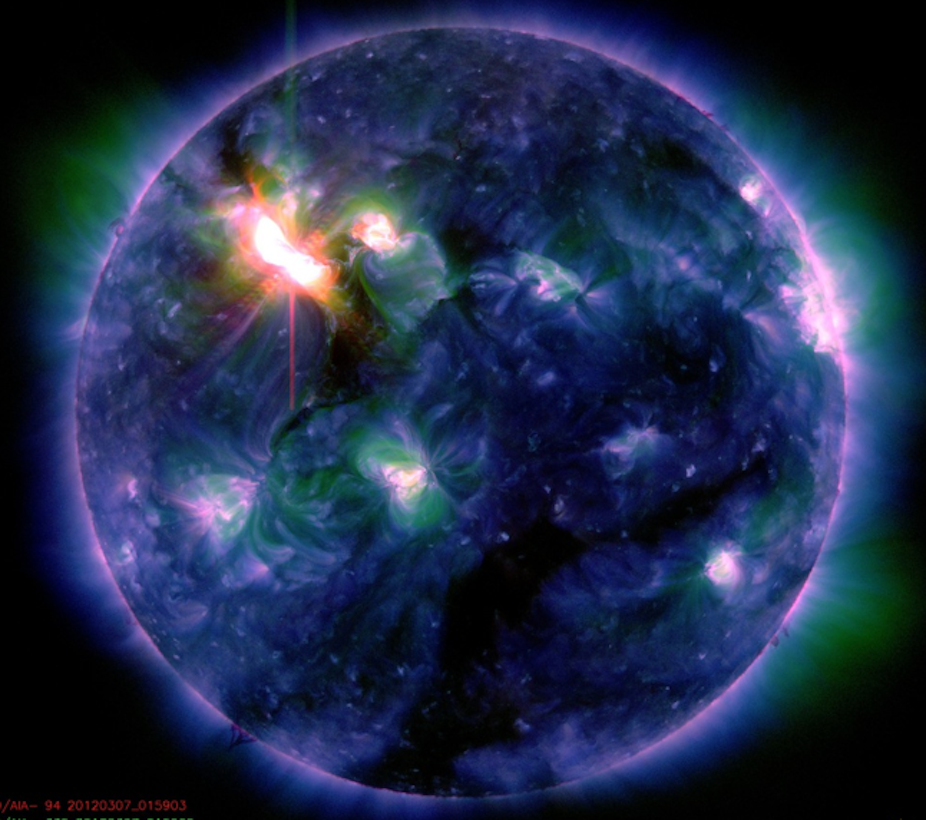The biggest space storm in five years is hurtling towards Earth at more than 2000 km per second. Two bursts of solar wind and plasma - known as coronal mass ejections (CME) - are expected to hit Earth after 5 p.m. AEST and could scramble high frequency radio communications, GPS systems and power grids, and disrupt satellites and airline flights, NASA said in a statement.
The US space agency said the storm was triggered by a solar flare in an active region on the Sun known as 1429 on Sunday, followed by a pair of solar flares on Tuesday and Wednesday. These set off a geomagnetic and solar radiation storm at level three on a five-step scale.
A solar flare is a massive energy release that spits clouds of electrons, ions and atoms through the corona of the Sun into space.
The brunt of the storm is expected to be felt through to Friday, and could give people in parts of Central Asia a clear view of the aurora borealis, or northern lights, tonight.
The storm is likely “the strongest one since December 2006,” said Joseph Kunches, a space weather scientist with the National Oceanic and Atmospheric Administration. The Earth had experienced a stronger radio blackout last August, but “if you put it all together with the geomagnetic effects and the solar radiation effects, I would put [this one] on par with one at the end of the last solar cycle, which was over five years ago.”
Geomagnetic and radiation storms will become more common as the Sun leaves its solar minimum period and moves into a solar maximum - the two extremes of the Sun’s activity cycle.
“The current increase in the number of X-class flares is part of the Sun’s normal 11-year solar cycle, during which activity on the Sun ramps up to solar maximum, which is expected to peak in late 2013,” the US space agency said in its statement.
Steven Tingay, a Professor of Radio Astronomy at Curtin University, said that electromagnetic fields in the CME could induce large currents in long conductors, such as power grids and telephone lines, causing them to quickly overload.
“In space, there can be issues with the electromagnetic radiation on communications satellites, which can cause them to stop functioning or reboot - and they’re expensive assets, so the damage can be substantial.
"We’re just starting to come into what should be a very active phase for the Sun over the next few years, so there should be more of these types of solar flares.”
The increasing dependence on high tech communications systems had made societies more vulnerable to these kinds of events, said Alina Donea, an astrophysicist at the Monash Centre for Astrophysics at Monash University. “But we should not panic. Previous flares have taught researchers lessons: we learned more about how to operate the instruments during extreme solar activity.”
The flare was expected to be of a similar size as one that occurred on February 14, 2000, Dr Donea said. “That flare was one of the largest geomagnetic storms of the previous solar cycle, accompanied by a massive CME and shock which was initially traveling at a speed of about 1800 km per second.
"It was big enough to cause the Earth’s magnetosphere [which is created by its magnetic field] to become extremely compressed and eroded … The Extreme ultraviolet Imaging Telescope (EIT) on NASA’s SOHO satellite found itself so bombarded by high flux from the sun that it became saturated and couldn’t record any useful readings.”
On that occasion the Sun also sent out solar energetic particles which, through a series of chemical reactions in our atmosphere, drastically diminished the upper-most areas of the ozone layer.
“We should expect more or less a similar impact to the Earth [this time],” Dr Donea said.


